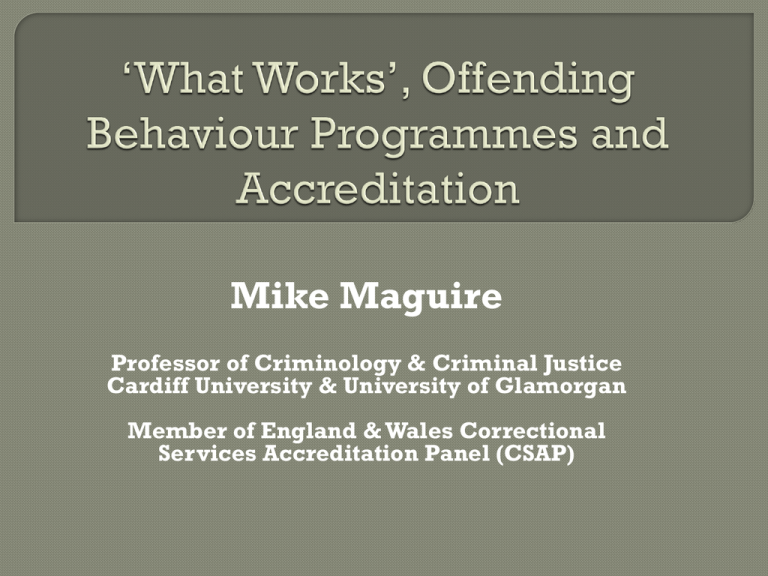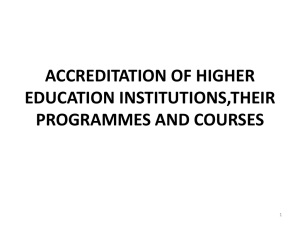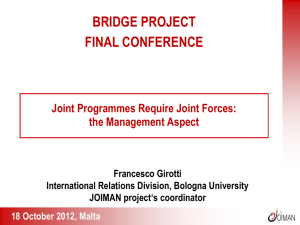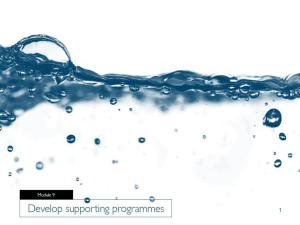
Mike Maguire
Professor of Criminology & Criminal Justice
Cardiff University & University of Glamorgan
Member of England & Wales Correctional
Services Accreditation Panel (CSAP)
Programmes and accreditation in UK: brief historical background
Recent developments in the UK:
Recent research
Changing ideas/theories/models and impact on programmes
The changing policy environment
Changing roles of Accreditation Panel
Issues of (hopefully mutual!) interest or concern
Mid-1990s: first CBT programmes run in prisons, early
accreditation panels set up
Late 1990s: Programmes in community championed by Chief
Inspector of Probation
2000 -03: ‘What Works’ major plank of government policy:
£400m Crime Reduction Programme, joint Prisons/
Probation Accreditation Panel (later CSAP) set up, huge
targets set for numbers to attend programmes
2003-5: After encouraging early results, evaluations
disappointing. Criticism of ‘programme fetishism’,
‘mechanical’ delivery. Moves to diversify interventions.
Panel advises more attention to ‘wrap around services’,
‘systems’ accreditation, responsivity/motivation.
2008: CSAP loses independent status, advisory only
New
government shows strong interest in
rehabilitation/reducing re-offending
Despite
cuts in Ministry of Justice, prisons
and probation, still strong support for
offending behaviour programmes
Despite
major cull of ‘quangos’, CSAP
continues to operate very actively (and
is taking on new roles)
Big datasets now available & can be combined, allowing:
Analysis of psychometric change
Large-scale re-offending and reconviction studies
More sophisticated matching of intervention and comparison samples:
Use of Propensity score matching
Inclusion of dynamic factors in comparing groups
Development of more sophisticated prediction tools (eg OGRS3, OVP, OGP)
Cohort studies
(Prison, Community and youth cohorts being tracked and re-interviewed)
Combine administrative data with self-report data
Analysis of impact of combinations of interventions, not just single programmes?
Hollis 2007
McDougall et al 2009
Internal analysis 2010 (not published)
Sadlier 2010
Analysis of all offenders referred to programmes in
the community, 2004:
5,000 non-starters, 12,000 non-completers,
8,000 completers (no matched comparison group)
All three groups were reconvicted less than
predicted (overall 10% fewer), but completers 26%
fewer, non-starters 4%, drop-outs 3%.
Those referred to programmes did better (10%
lower reconviction rate than predicted) than those on
other community interventions (7%)
All stat. sig. except women’s and DV programmes
Weaknesses in study, but good indicative evidence
Methodologically
robust study (RCT) of
psychometric change in prisoners
attending Enhanced Thinking Skills
Significant improvement in ‘impulsivity’
scores (a major criminogenic need), also in
attitudes to offending and fewer discipline
reports in prison
These
improvements should (but will they?)
translate into reduced re-offending
17,000
prisoners attending ETS 2000-05
(completers and drop-outs), compared
with cohort of 19,000 other prisoners
released in same years
Predicted reconviction rates for the two
groups were similar, but ETS group
reconvicted significantly (18%) less than
predicted ; cohort only 3% less.
Completers even better
Best evidence yet? Combines data from prisoner
cohort study, OASys, Offending Behaviour Programmes
database, PNC. Minimises selection effects.
Propensity score matching on ETS suitability criteria
(risk, responsivity, needs), static and dynamic risk
factors (motivation, attitudes to crime, substance
misuse, education, etc) = best matched samples so far
One-year reoffending: ETS group 27%, cohort 33%
ETS group 60 offences per 100 ex-prisoners, cohort 120
Prisoners ‘suitable’ for ETS did better than those not
‘Risk- needs’ model challenged or modified,
particularly by:
‘Desistance’ literature (Maruna, Farrall)
(Desistance achieved mainly through individual agency,
motivation, readiness to change, personal narratives; + new
skills, opportunities, social capital; change is not a one-off
event – often a ‘zigzag’ process with frequent relapse)
‘Good Lives’ model (Ward, Hudson, etc)
(A fulfilling life depends on achieving a range of ‘human
goods’ - eg knowledge, creativity, friendship, relatedness –
through pro-social means. Therapy should focus on ‘whole
person’, strengths not deficits, healthy lifestyle, skills)
Focus on sustaining motivation, belief that change is possible
E.g. ‘FOR’ and ‘Bridge’(‘cognitive motivational’ /’belief’ programmes); ‘boosters’
Focus on individuals
E.g. More one-to-one work within group programmes
Focus on staff skills, responsivity, engagement, trusting relationships
E.g. Offender Engagement Programme, ‘therapeutic alliance’, mentoring
Focus on opportunities, access to services, building social capital
E.g. ‘wrap around’ services, ‘continuity’, resettlement , the FOR ‘market place’
Focus on applying learning and skills to ‘real world’
E.g. more Therapeutic Communities. Also ‘hybrid’ interventions (eg a CBT
programme delivered within a dedicated TC-like prison wing)
Major financial cuts
Prison overcrowding
Indeterminate sentence prisoners
The ‘rehabilitation revolution’ :
‘Payment by results’
‘Localism’ and local commissioning
‘Contestability’ (private/vol/faith)
(What is the place of expensive
accredited programmes in all this?)
Fewer
qualified staff (eg Treatment Managers)
Audit resources cut (now 2-year cycle)
‘Rationalisation’ of programmes portfolio
(fewer programmes, ‘one size fits all’)
Pooled training (less programme-specific)
Less central influence on control of : local
commissioners less willing to buy expensive
programmes
No
longer independent – but this so far
has not affected accreditation
Broader advice role – eg CARATS, DRR,
methadone, new programmes (eg for low
IQ/women/research methodology/short
sentence prisoners/juveniles)
Regular sub-panel advises MoJ on
research strategy
• A clear model of change
• Selection of Offenders
• Targeting a range of dynamic risk factors
• Effective methods
• Skills orientated
• Sequencing, intensity and duration
• Engagement and motivation
• Continuity of Programmes and Services
• Process Evaluation and Maintaining Integrity?
• Ongoing Evaluation.
A programme must score between 18-20 points to be awarded
accredited status. The Panel will award recognised/provisionally
accredited status where it has identified the need for specific
changes that can be made in less than 12 months (or longer, where
specified) and the programme has reached a score of around 16
points.
Public/political/practice/academic image of Panel – how created?
(e.g. Cann research - image of failure? Mair critique - seen as
central control, stifling innovation/diversity? How counteract?)
IF SEVERE CUTS THREATEN STANDARDS, HOW TO RESPOND?
How maintain political case for continued funding (of both Panel
and programmes) Lobbying, ear of ministers? Sir Duncan has
gone. Where located in Ministry – who ‘bats for’ (cricket term!)?
Try to influence supply of resources via accreditation? – set
levels of training, qualification, psychometrics, facilitator,
preparation hours, audit criteria – but risk pricing selves out of
market? (and it is a market now)
Should Panel oppose (and if so, how?) one size fits all/
‘modularisation’/ rolling programmes?
Ditto shorter programmes? Ditto lower qualified staff?
More generally, what should be the role of the Panel and
its limits? Should it accredit only? Reactively, or should it
comment on what kinds of programmes are needed?
Offer wider advice on interventions? Or even have a
collective (and sometimes critical) ‘voice’ aimed at
influencing policy in the direction of effective interventions
and evidence-led research?
How ‘political’ can it be?: resist damaging policies? Eg
excessive government targets, pressure on the Panel to
accredit prematurely?
Does ‘loss of independence’ make a difference?
In E & W now, many subpanels, few plenaries – we are very
dispersed (USA members + drugs/sex/ TC/general) and
less ‘voice’ (used to have VIP visitors!)
Accredition criteria – should they include ‘continuity’? (and
management/training/audit arrangements?) Justification =
e.g Andrews’ Core Correctional Methods and Lowenkamp
(CPAI – key role of delivery standards, staff skills and ‘wrap
around’ services in what works)
‘Systems’ accreditation? (ECP/CARATS?)
Use of ‘bought in’ material accredited elsewhere (eg
American ‘workbooks’ as part of a ‘programme’– what are
we accrediting?)
‘Second level’ accreditation? (e.g. intervention ‘contributes’
but not expected to reduce offending itself) Is this Panel
business?
Non-accredited programmes?
Other standards/accreditation bodies – eg health, education
Should panels ‘site accredit’ (explain it to me!)? Visit as part of
accred process? How many sites?
Does a programme have to be running before accreditation?
Audit in E & W now ‘pass/fail/exceed’ – compliance and quality
separate.
Different standards prisons-community?
Video-monitoring?
How much should Panel get involved in field and implementation
issues? Panel did oversee and sign off each site – now just
approve criteria and instruments (though sex offenders more
hands-on – look at products, close involvement in audit,
implementation advice)
Visits and other contact with ‘the field’. Why?
Are
models changing? – e.g. incorporate
desistance/motivation/Good Lives
Therapeutic Communities?
12 steps etc?
Faith as a main engine of change?
Implications of? (non-believers? Other
faiths? pressure to attend?)
Do criteria deter non-CBT accreditation?
What level of ‘proof’ of effectiveness should be
required? What methods? Who pays?
Reality in UK = very little evaluation, so how
should the Panel respond?:
‘Face facts’ and remove criterion 10 (required evaluation)?
Accept ‘indicators’ of effectiveness (e.g. psychometric change?)
Accept e.g. ‘CBT works, therefore this programme will’?
Wait for cohort studies?
Demand robust evaluation: if not, de-accredit?
Five year reviews – what new evidence required?
What sanctions applied?
People with high psychopathy scores?
Low IQ/learning difficulties?
Low risk?
Short-termers?
‘Deniers’
Women and men together/’singletons’?
Mix differently motivated offenders? eg street/
domestic/racial violence, anger/controlled?
UK: trend was to growing numbers of specialist
programmes – now ‘one size fits all’
Who misses out? Short-termers? Low IQ/ low
reading skills? Juveniles? BME?
Who decides which programmes reach the Panel
(for advice/accreditation?) Should anyone have
a right to apply (perhaps if pay?) If not - filtering,
who does it? Secretariat? Panel itself? (reactive
versus passive) Is it a free for all, or driven by
policy – we need some programmes of x type’?
Submissions for ‘advice’ – Who pays?
(commercial value of accreditation = some get
free advice? Also should MoJ help in
developing?)
Psychometrics? What purpose? (assessment, clinical
follow-up/feedback? Evaluation?) Limit? Need to do
for every offender or sample?
Accountability/Evaluation of the Panel (Cambridge
evaluated but long time ago). No member appraisals
in E &W – but we may quietly not be reappointed!
Annual report very open (minutes of plenaries,
copies of applications, letters to developers etc.)
Panel membership: expertise? (UK = mix plus draft
in guest experts); ‘generalists’? Should it include
‘insiders’?
Last but very important – Diversity Criteria.






